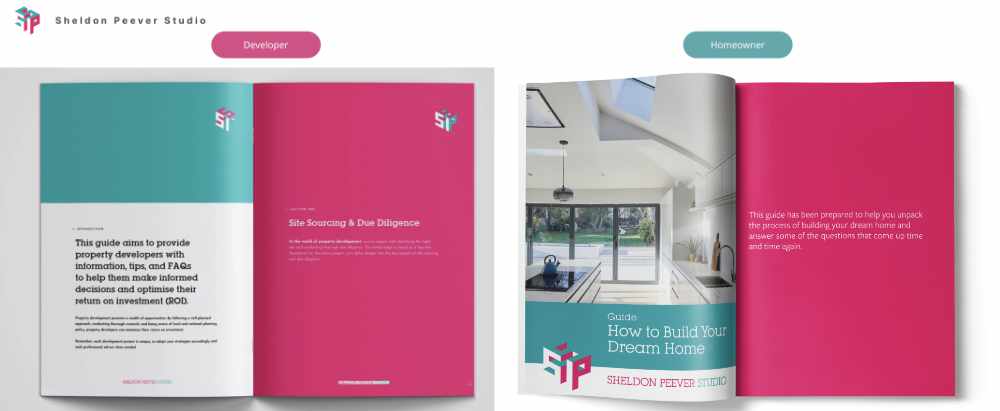Christine Peever, Architect and Director of Sheldon Peever Studio
[edit] Introducing Christine Peever, Architect and Director of Sheldon Peever Studio
Christine has now been running her own practice for over 10 years, working on a number of residential and education projects, from feasibility through to completion and defects, with residential schemes, often on tight urban sites with listed buildings or conservation areas, being a prime focus.
The practice works throughout London and the Home Counties, looking to deliver carefully considered, cutting-edge, and sustainable schemes, providing a personalised service to their clients, and negotiating on their behalf with local authority planning and conservation departments.
We caught up with Christine to hear about some of the benefits and challenges of working in a small practice on smaller schemes at this time.
[edit]
[edit] Biodiversity net gain, tips and tools for small sites
Quite topical in a way, with the recent World Environment Day, but more specifically, biodiversity net gain, or BNG as it is known now, is a new area of work we are currently getting to grips with. Biodiversity Net Gain is also becoming more prevalent, especially since April 2024, when all developments (albeit with exemptions) now have to have a BNG assessment completed for planning applications. Legislation has come into force, but without the learning resources to support it.
We have our first new build project in Hertfordshire where this is applicable, so it’s a bit of a learning curve at the moment, and I’m learning a lot about habitat banks as it’s likely we’ll need to use one. Fortunately, we have a great relationship with an ecologist, so they have been educating us on everything BNG. Ultimately, the reasons are well placed; I just hope it doesn’t become a tick-box exercise. Maybe this is a route for architects to specialise further?
[edit] Registered building inspectors; building types and conflicts of interest updates
The October 2023 changes to building regulations, specifically in relation to the Building Safety Act 2022, have a lot of members of the construction industry scratching their heads at the moment. This specifically relates to smaller practices that are not working on high-risk buildings and have limited time and resources. #
There is such a lack of clarity and contradictory information being issued by various LABC bodies and institutions that it becomes confusing. At the end of the day, we just want to know if what we as architects are doing complies with the Act and other new PD regulations. I believe most architects are already doing this, but it needs to be formally managed and documented.
[edit] Appointing an architect
This is just a simple article on employing an architect, but it is useful to have. We often have to explain to clients how the process works and what our services are, and it is always good to be clear at the start. That is why we developed some guides for both clients and developers. You can find them in the section below.
[edit]
[edit] World Environment Day
World Environment Day this year has the theme Generation Restoration, which is, in effect, what the BNG aims for.
https://www.worldenvironmentday.global/.
[edit] Embodied biodiversity ?
Embodied biodiversity: the next step for sustainability in construction is an interesting concept beyond BNG, once we all understand that fully.
[edit] Building Safety Act for small practices
Building Safety Act: how one small architecture practice is adapting to the new regime; some similarities here
[edit] Sheldon Peever Client and Developer Guides
We developed these short guides, which help explain what is on offer and the processes we work through for the best results.
[edit] Can you tell us a little about your background, activities and interest in buildings?
I wanted to be an architect from quite an early age. I had an interest in creating things and I also enjoyed math and science. My dad taught me some basic technical drawing skills at age 10, and I was hooked. I think I could have easily slid into engineering, but architecture felt like a good blend of technical and creative abilities.
I worked in London on housing, schools, and children's centres in the early noughts and started my own practice in 2012 after taking voluntary redundancy. The practice is based in St. Albans and works on a mixture of private residential and small-scale developments in London and the home counties.
One of the ethos of the practice is to work in and with the local economy. That means, where possible, using local independent suppliers, from printing to builders and other consultants.
We also not only work with our clients; we educate them through the process. It’s a bad habit architects have of speaking in a language that isn’t always easy to decipher. We, as a practice, break down what we do and how we do it into easy-to-understand chunks so that our clients get the best experience and outcome for their project.
[edit] Do you think there are specific areas of knowledge that are lacking across the industry?
Relating to the Building Safety Act mentioned, and in particular for smaller practices that are not working on high-risk buildings and have limited time and resources, A general observation of, for example, the RIBA is that the majority of CPD and information sharing is geared towards bigger projects and practices. Which results in micropractices feeling that their CPD requirements are not being met for the scale and type of work they do.
There is also a feeling within smaller practices that having to outlay a not-inconsiderable amount of money to be taught how to meet a statutory requirement (BSA/PD) doesn’t really feel right. Surely, if this is a baseline legal requirement, the information should be freely available to members rather than behind a paywall?
[edit] Do you think there is value in sharing knowledge across disciplines and institutions and why?
Definitely. Every project that we deliver, we do so as a team, and that team should share knowledge in order to get the best outcome from a project. I don’t begin to think that, as architects, we know it all. Pulling on the knowledge base of other disciplines is immensely beneficial for individuals in their personal and professional development. In the same way we educate clients and other designers, we should be learning all the time.
[edit] What do you think are the main barriers and possible solutions to sharing and applying knowledge?
Time: Setting aside time to collaborate with other designers to programme in CPD-style events where we can sit in and discuss a project from an engineer's perspective. In micropractices, this takes time and resources, and unfortunately, a lot of people don’t have that luxury.
Physical: if different disciplines shared office space, the opportunity for ad hoc discussions would be immensely beneficial to all. I know this happens in larger multi-discipline companies, but it’s much harder for micro-practices to have the same experience.
Possible solutions: different governing boards (RIBA, RICS, CIOB, etc.) talking to each other to create events to enable cross-discipline discussions, not just for larger practices but for small practices at the regional or county level. There is plenty of opportunity at this level, and I firmly believe in boosting the local economy. Additional benefits would be creating a regional team that could put forward bids for large-scale work based in the area rather than parachuting in consultants from elsewhere.
[edit] How did you first discover our forum for finding and sharing knowledge here at Designing Buildings?
It was quite a long time ago, but it was likely looking for some information on JCT contractual matters.
[edit] What are your general impressions of the Designing Buildings site and microsites?
The site offers a wide range of articles, guides, and resources that cover various aspects of building design, construction processes, and industry best practices. This extensive content library makes it a valuable reference for professionals at all levels.
As an educational platform, it provides in-depth articles that explain complex concepts in an accessible language. This is particularly useful for students and early-career professionals seeking to deepen their understanding.
Overall, it is a valuable resource for anyone involved in the built environment. They provide a blend of theoretical knowledge, practical tools, and community engagement that supports continuous learning and professional development.
[edit] Do you have any favourite themes relating to buildings and construction, particular eras of construction, styles, technical areas or any favourite building that springs to mind?
As a practice, we don’t have a specific design style, although we have repeated themes in all our projects relating to views, connection with the outdoors, natural light, and ventilation. I personally like the current resurgence of post-war and mid-century design and how the themes of that era are coming back into play: natural light, simple materials, and honest detailing.
At the moment, we’re working on an existing 1960s house. It’s a concrete-framed building with a brick facade. We’re at the early stages of design, but it’s fascinating to learn how the building was built, which will then inform our design and technical approach.
[edit] Please could you give us a little feedback on the experience of being our guest editor and nominate a potential candidate for a future guest editor slot?
Pedro Gil - Studio Gil. An old friend and confident, that inspired me to start out on my own.
Featured articles and news
Independent Building Control review panel
Five members of the newly established, Grenfell Tower Inquiry recommended, panel appointed.
ECA progress on Welsh Recharging Electrical Skills Charter
Working hard to make progress on the ‘asks’ of the Recharging Electrical Skills Charter at the Senedd in Wales.
A brief history from 1890s to 2020s.
CIOB and CORBON combine forces
To elevate professional standards in Nigeria’s construction industry.
Amendment to the GB Energy Bill welcomed by ECA
Move prevents nationally-owned energy company from investing in solar panels produced by modern slavery.
Gregor Harvie argues that AI is state-sanctioned theft of IP.
Heat pumps, vehicle chargers and heating appliances must be sold with smart functionality.
Experimental AI housing target help for councils
Experimental AI could help councils meet housing targets by digitising records.
New-style degrees set for reformed ARB accreditation
Following the ARB Tomorrow's Architects competency outcomes for Architects.
BSRIA Occupant Wellbeing survey BOW
Occupant satisfaction and wellbeing tool inc. physical environment, indoor facilities, functionality and accessibility.
Preserving, waterproofing and decorating buildings.
Many resources for visitors aswell as new features for members.
Using technology to empower communities
The Community data platform; capturing the DNA of a place and fostering participation, for better design.
Heat pump and wind turbine sound calculations for PDRs
MCS publish updated sound calculation standards for permitted development installations.
Homes England creates largest housing-led site in the North
Successful, 34 hectare land acquisition with the residential allocation now completed.
Scottish apprenticeship training proposals
General support although better accountability and transparency is sought.
The history of building regulations
A story of belated action in response to crisis.
Moisture, fire safety and emerging trends in living walls
How wet is your wall?
Current policy explained and newly published consultation by the UK and Welsh Governments.
British architecture 1919–39. Book review.
Conservation of listed prefabs in Moseley.
Energy industry calls for urgent reform.





































